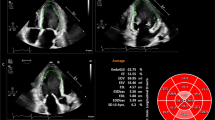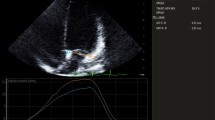Abstract
Exercise echocardiography is an underutilized tool in pediatrics with current applications including detecting segmental wall abnormalities, assessing the utility of global ventricular function, and measuring pulmonary hemodynamics. No prior study has applied speckle-tracking echocardiography (STE) during exercise echocardiography in children. The aim of this study was to determine the feasibility of measuring speckle-tracking-derived peak systolic velocities, global longitudinal and circumferential strain, and global strain rates at various phases of exercise. Ninety-seven healthy children underwent cardiopulmonary exercise testing using supine cycle ergometry. The exercise stress test consisted of baseline pulmonary function testing, monitoring of blood pressure and heart rate responses, electrocardiographic recordings, and oxygen saturations while subjects pedaled against a ramp protocol based on body weight. Echocardiographic measurements and specifically speckle-tracking analysis were performed during exercise at baseline, at a heart rate of 160 beats per minute and at 10 min after exercise. Peak systolic velocity, peak systolic strain, and peak systolic strain rate at these three phases were compared in the subjects in which all measurements were accurately obtained. We were able to complete peak velocity, strain, and strain rate measurements in all three exercise phases for 36 out of the 97 subjects tested. There was no significant difference between the feasibility of measuring circumferential versus longitudinal strain (p = 0.25, B-corrected = 0.75). In the 36 subjects studied, the magnitude of circumferential strain values decreased from −18.3 ± 4.8 to −13.7 ± 4.0 % from baseline to HR 160 (p < 0.0001, B-corrected < 0.0001), before returning to −19.6 ± 4.4 % at recovery (p = 0.19 when compared to baseline). Longitudinal strain did not vary significantly from baseline to HR 160 (from −17.7 ± 4.4 to −16.6 ± 4.4 %, p = 0.16); likewise the average recovery strain was no different from those values (−18.4 ± 3.6 %; p = 0.34). Peak circumferential and longitudinal strain rates increased from baseline to HR 160, but neither decreased to baseline levels after 10 min of recovery, which correlated with heart rate variations with exercise. We studied the effects of frame rate on deformation measurements and we observed no difference between measurements taken at lower (<60 frames per second, fps) and higher (≥60 fps) frame rates. This study shows that it is technically difficult to retrospectively measure peak velocities, strain, and strain rate in exercising pediatric subjects with STE. The majority of subjects that were excluded from the study had inadequate echocardiographic images when tachycardic from increased respiratory effort and body movements near peak exercise. Improvements in technique and higher image frame rates could make application of STE to pediatric cardiopulmonary testing more successful in the future.


Similar content being viewed by others
References
Al-Biltagi M, Tolba O, Rowisha M, Mahfouz A-S, Elewa M (2015) Speckle tracking and myocardial tissue imaging in infant of diabetic mother with gestational and pregestational diabetes. Pediatr Cardiol 36(2):445–453. doi:10.1007/s00246-014-1033-0
Amundsen B, Helle-Valle T, Edvardsen T, Torp H, Crosby J, Lyseggen Asbjorn Stoylen A, Ihlen H, Lima Smiseth O, Slordahl S (2006) Noninvasive myocardial strain measurement by speckle tracking echocardiography validation against sonomicrometry and tagged magnetic resonance imaging. J Am Coll Cardiol 47(4):789–793
Arunamata A, Selamet Tierney ES, Tacy TA, Punn R (2014) Echocardiographic measures associated with early postsurgical myocardial dysfunction in pediatric patients with mitral valve regurgitation. J Am Soc Echocardiogr 28(3):284–293. doi:10.1016/j.echo.2014.11.010
Bansal M, Cho G-Y, Chan J, Leano R, Haluska BA, Marwick TH (2008) Feasibility and accuracy of different techniques of two-dimensional speckle based strain and validation with harmonic phase magnetic resonance imaging. J Am Soc Echocardiogr 21(12):1318–1325
Berberich SN, Zager JRS, Plotnick GD, Fisher ML (1984) A practical approach to exercise echocardiography: immediate postexercise echocardiography. J Am Coll Cardiol 3(2s1):284–290. doi:10.1016/S0735-1097(84)80011-X
Bussadori C, Moreo A, Di Donato M, De Chiara B, Negura D, Dall’Aglio E, Lobiati E, Chessa M, Arcidiacono C, Dua J, Mauri F, Carminati M (2009) A new 2D-based method for myocardial velocity strain and strain rate quantification in a normal adult and paediatric population: assessment of reference values. Cardiovasc Ultrasound 7(1):8
Carasso S, Yang H, Anna Woo A, Vannan M, Jamorski M, Douglas M, Rakowski H (2008) Systolic myocardial mechanics in hypertrophic cardiomyopathy: novel concepts and implications for clinical status. J Am Soc Echocardiogr 21(6):675–683
Carasso S, Biaggi P, Rakowski H, Mutlak D, Lessick J, Aronson D, Woo A, Agmon Y (2012) Velocity vector imaging: standard tissue-tracking results acquired in normals—The VVI-STRAIN study. J Am Soc Echocardiogr 25(5):543–552
Davidavicius G, Kowalski M, Williams RI, D’hooge J, Di Salvo G, Pierre-Justin G, Claus P, Rademakers F, Herregods M-C, Fraser AG, Pierard LA, Bijnens B, Sutherland GR (2003) Can regional strain and strain rate measurement be performed during both dobutamine and exercise echocardiography, and do regional deformation responses differ with different forms of stress testing? J Am Soc Echocardiogr 16(4):299–308
D’hooge J, Heimdal A, Jamal F, Kukulski T, Bijnens B, Rademakers F, Hatle L, Suetens P, Sutherland G (2000) Regional strain and strain rate measurements by cardiac ultrasound: principles, implementation and limitations. Eur J Echocardiogr 1(3):154–170
Di Salvo G, Drago M, Pacileo G, Carrozza M, Santoro G, Bigazzi MC, Caso P, Russo MG, Carminati M, Calabró R (2005) Comparison of strain rate imaging for quantitative evaluation of regional left and right ventricular function after surgical versus percutaneous closure of atrial septal defect. Am J Cardiol 96(2):299–302
Di Salvo G, Pacileo G, Del Giudice EM, Natale F, Limongelli G, Verrengia M, Rea A, Fratta F, Castaldi B, D’Andrea A, Calabrò P, Miele T, Coppola F, Russo MG, Caso P, Perrone L, Calabrò R (2006) Abnormal myocardial deformation properties in obese, non-hypertensive children: an ambulatory blood pressure monitoring, standard echocardiographic, and strain rate imaging study. Eur Heart J 27(22):2689–2695. doi:10.1093/eurheartj/ehl163
Eyskens B, Weidemann F, Kowalski M, Bogaert J, Dymarkowski S, Bijnens B, Gewillig M, Sutherland G, Mertens L (2004) Regional right and left ventricular function after the Senning operation: an ultrasonic study of strain rate and strain. Cardiol Young 14(03):255–264. doi:10.1017/S1047951104003038
Fine N, Shah A, Han I-Y, Yu Y, J-f Hsiao, Koshino Y, Saleh H, Miller F Jr, Oh J, Pellikka P, Villarraga H (2013) Left and right ventricular strain and strain rate measurement in normal adults using velocity vector imaging: an assessment of reference values and intersystem agreement. Int J Cardiovasc Imaging 29(3):571–580. doi:10.1007/s10554-012-0120-7
Ganame J, Claus P, Uyttebroeck A, Renard M, D’hooge J, Bijnens B, Sutherland GR, Eyskens B, Mertens L (2007) Myocardial dysfunction late after low-dose anthracycline treatment in asymptomatic pediatric patients. J Am Soc Echocardiogr 20(12):1351–1358
Gayat E, Ahmad H, Weinert L, Lang RM, Mor-Avi V (2011) Reproducibility and inter-vendor variability of left ventricular deformation measurements by three-dimensional speckle-tracking echocardiography. J Am Soc Echocardiogr 24(8):878–885
Goebel B, Arnold R, Koletzki E, Ulmer H, Eichhorn J, Borggrefe M, Figulla H, Poerner T (2007) Exercise tissue Doppler echocardiography with strain rate imaging in healthy young individuals: feasibility, normal values and reproducibility. Int J Cardiovasc Imaging 23(2):149–155. doi:10.1007/s10554-006-9130-7
Hauser M, Petzuch K, Kühn A, Schön P, Elmenhorst J, Schönfelder M, Oberhoffer R, Vogt M (2013) The munich triathlon heart study: ventricular function, myocardial velocities, and two-dimensional strain in healthy children before and after endurance stress. Pediatr Cardiol 34(3):576–582. doi:10.1007/s00246-012-0500-8
Ingul C, Torp H, Aase S, Berg S, Stoylen A, Slordahl S (2005) Automated analysis of strain rate and strain: feasibility and clinical implications. J Am Soc Echocardiogr 18:411–418
Khoo NS, Smallhorn JF, Kaneko S, Kutty S, Altamirano L, Tham EB (2013) The assessment of atrial function in single ventricle hearts from birth to fontan: a speckle-tracking study by using strain and strain rate. J Am Soc Echocardiogr 26(7):756–764
Koopman LP, Slorach C, Manlhiot C, McCrindle BW, Jaeggi ET, Mertens L, Friedberg MK (2011) Assessment of myocardial deformation in children using digital imaging and communications in medicine (DICOM) data and vendor independent speckle tracking software. J Am Soc Echocardiogr 24(1):37–44
Lee J-H, Park J-H, Park K-I, Kim MJ, Kim JH, Ahn MS, Choi SW, Jeong J-O, Seong I-W (2014) A comparison of different techniques of two-dimensional speckle-tracking strain measurements of right ventricular systolic function in patients with acute pulmonary embolism. J Cardiovasc Ultrasound 22(2):65–71. doi:10.4250/jcu.2014.22.2.65
Leitman M, Lysyansky P, Sidenko S, Shir V, Peleg E, Binenbaum M, Kaluski E, Krakover R, Vered Z (2004) Two-dimensional strain-a novel software for real-time quantitative echocardiographic assessment of myocardial function. J Am Soc Echocardiogr 17:1021–1029
Lorch SM, Ludomirsky A, Singh GK (2008) Maturational and growth-related changes in left ventricular longitudinal strain and strain rate measured by two-dimensional speckle tracking echocardiography in healthy pediatric population. J Am Soc Echocardiogr 21(11):1207–1215
Lowenthal A, Tacy T, Behzadian F, Punn R (2013) Echocardiographic predictors of early postsurgical myocardial dysfunction in pediatric patients with aortic valve insufficiency. Pediatr Cardiol 1–9. doi:10.1007/s00246-013-0646-z
Marcus KA, Mavinkurve-Groothuis AMC, Barends M, van Dijk A, Feuth T, de Korte C, Kapusta L (2011) Reference values for myocardial two-dimensional strain echocardiography in a healthy pediatric and young adult cohort. J Am Soc Echocardiogr 24(6):625–636
Marwick TH (2010) Consistency of myocardial deformation imaging between vendors. Eur J Echocardiogr 11(5):414–416. doi:10.1093/ejechocard/jeq006
Mitsnefes MM, Kimball TR, Witt SA, Glascock BJ, Khoury PR, Daniels SR (2003) Left ventricular mass and systolic performance in pediatric patients with chronic renal failure. Circulation 107(6):864–868. doi:10.1161/01.cir.0000049744.23613.69
Pauliks L, Brian Clark J, Rogerson A, DiPietro A, Myers J, Cyran S (2012) Exercise stress echocardiography after childhood ross surgery: functional outcome in 26 patients from a single institution. Pediatr Cardiol 33(5):797–801. doi:10.1007/s00246-012-0218-7
Perk G, Tunick PA, Kronzon I (2007) Non-Doppler two-dimensional strain imaging by echocardiography-from technical considerations to clinical applications. J Am Soc Echocardiogr 20(3):234–243
Punn R, Obayashi DY, Olson I, Kazmucha JA, DePucci A, Hurley MP, Chin C (2012) Supine exercise echocardiographic measures of systolic and diastolic function in children. J Am Soc Echocardiogr 25(7):773–781
Riopel DA (1979) Blood pressure, heart rate, pressure-rate product and electrocardiographic changes in healthy children during treadmill exercise. Am J Cardiol 44(4):697–704
Risum N, Ali S, Olsen NT, Jons C, Khouri MG, Lauridsen TK, Samad Z, Velazquez EJ, Sogaard P, Kisslo J (2012) Variability of global left ventricular deformation analysis using vendor dependent and independent two-dimensional speckle-tracking software in adults. J Am Soc Echocardiogr 25(11):1195–1203. doi:10.1016/j.echo.2012.08.007
Rowland T, Bhargava R, Parslow D, Heptulla RA (2003) Cardiac response to progressive cycle exercise in moderately obese adolescent females. J Adolesc Health 32(6):422–427
Sicari R, Nihoyannopoulos P, Evangelista A, Kasprzak J, Lancellotti P, Poldermans D, Voigt J-U, Zamorano JL (2009) Stress echocardiography expert consensus statement—executive summary: European Association of Echocardiography (EAE) (a registered branch of the ESC). Eur Heart J 30(3):278–289. doi:10.1093/eurheartj/ehn492
Weesner KM, Bledsoe M, Chauvenet A, Wofford M (1991) Exercise echocardiography in the detection of anthracycline cardiotoxicity. Cancer 68(2):435–438.
Wilkenshoff UM, Sovany A, Wigström L, Olstad B, Lindström L, Engvall J, Janerot-Sjöberg B, Wranne B, Hatle L, Sutherland GR (1998) Regional mean systolic myocardial velocity estimation by real-time color doppler myocardial imaging: a new technique for quantifying regional systolic function. J Am Soc Echocardiogr 11(7):683–692
Wittlieb-Weber CA, Cohen MS, McBride MG, Paridon SM, Morrow R, Wasserman M, Wang Y, Stephens P Jr (2013) Elevated left ventricular outflow tract velocities on exercise stress echocardiography may be a normal physiologic response in healthy youth. J Am Soc Echocardiogr 26(12):1372–1378. doi:10.1016/j.echo.2013.08.020
Yingchoncharoen T, Agarwal S, Popović ZB, Marwick TH (2013) Normal ranges of left ventricular strain: a meta-analysis. J Am Soc Echocardiogr 26(2):185–191
Acknowledgments
The study was funded through the Lucile Packard Children’s Hospital Innovations in Patient Care grant.
Author information
Authors and Affiliations
Corresponding author
Ethics declarations
Conflict of interest
None.
Rights and permissions
About this article
Cite this article
Liu, M.Y., Tacy, T., Chin, C. et al. Assessment of Speckle-Tracking Echocardiography-Derived Global Deformation Parameters During Supine Exercise in Children. Pediatr Cardiol 37, 519–527 (2016). https://doi.org/10.1007/s00246-015-1309-z
Received:
Accepted:
Published:
Issue Date:
DOI: https://doi.org/10.1007/s00246-015-1309-z




